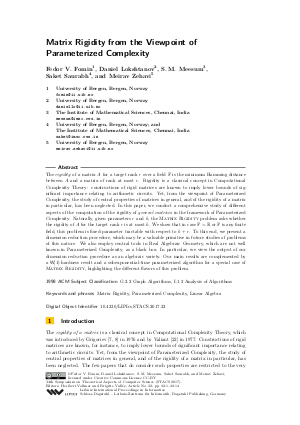Matrix Rigidity from the Viewpoint of Parameterized Complexity
Authors Fedor V. Fomin, Daniel Lokshtanov, S. M. Meesum, Saket Saurabh, Meirav Zehavi
-
Part of:
Volume:
34th Symposium on Theoretical Aspects of Computer Science (STACS 2017)
Part of: Series: Leibniz International Proceedings in Informatics (LIPIcs)
Part of: Conference: Symposium on Theoretical Aspects of Computer Science (STACS) - License:
 Creative Commons Attribution 3.0 Unported license
Creative Commons Attribution 3.0 Unported license
- Publication Date: 2017-03-06
File

PDF
LIPIcs.STACS.2017.32.pdf
- Filesize: 0.49 MB
- 14 pages
Document Identifiers
Subject Classification
Keywords
- Matrix Rigidity
- Parameterized Complexity
- Linear Algebra
Metrics
- Access Statistics
-
Total Accesses (updated on a weekly basis)
0Document
0Metadata
Abstract
The rigidity of a matrix A for a target rank r over a field F is the minimum Hamming distance between A and a matrix of rank at most r. Rigidity is a classical concept in Computational Complexity Theory: constructions of rigid matrices are known to imply lower bounds of significant importance relating to arithmetic circuits. Yet, from the viewpoint of Parameterized Complexity, the study of central properties of matrices in general, and of the rigidity of a matrix in particular, has been neglected. In this paper, we conduct a comprehensive study of different aspects of the computation of the rigidity of general matrices in the framework of Parameterized Complexity. Naturally, given parameters r and k, the Matrix Rigidity problem asks whether the rigidity of A for the target rank r is at most k. We show that in case F equals the reals or F is any finite field, this problem is fixed-parameter tractable with respect to k+r. To this end, we present a dimension reduction procedure, which may be a valuable primitive in future studies of problems of this nature. We also employ central tools in Real Algebraic Geometry, which are not well known in Parameterized Complexity, as a black box. In particular, we view the output of our dimension reduction procedure as an algebraic variety. Our main results are complemented by a W[1]-hardness result and a subexponential-time parameterized algorithm for a special case of Matrix Rigidity, highlighting the different flavors of this problem.
Cite As Get BibTex
Fedor V. Fomin, Daniel Lokshtanov, S. M. Meesum, Saket Saurabh, and Meirav Zehavi. Matrix Rigidity from the Viewpoint of Parameterized Complexity. In 34th Symposium on Theoretical Aspects of Computer Science (STACS 2017). Leibniz International Proceedings in Informatics (LIPIcs), Volume 66, pp. 32:1-32:14, Schloss Dagstuhl – Leibniz-Zentrum für Informatik (2017)
https://doi.org/10.4230/LIPIcs.STACS.2017.32
BibTex
@InProceedings{fomin_et_al:LIPIcs.STACS.2017.32,
author = {Fomin, Fedor V. and Lokshtanov, Daniel and Meesum, S. M. and Saurabh, Saket and Zehavi, Meirav},
title = {{Matrix Rigidity from the Viewpoint of Parameterized Complexity}},
booktitle = {34th Symposium on Theoretical Aspects of Computer Science (STACS 2017)},
pages = {32:1--32:14},
series = {Leibniz International Proceedings in Informatics (LIPIcs)},
ISBN = {978-3-95977-028-6},
ISSN = {1868-8969},
year = {2017},
volume = {66},
editor = {Vollmer, Heribert and Vall\'{e}e, Brigitte},
publisher = {Schloss Dagstuhl -- Leibniz-Zentrum f{\"u}r Informatik},
address = {Dagstuhl, Germany},
URL = {https://drops.dagstuhl.de/entities/document/10.4230/LIPIcs.STACS.2017.32},
URN = {urn:nbn:de:0030-drops-70019},
doi = {10.4230/LIPIcs.STACS.2017.32},
annote = {Keywords: Matrix Rigidity, Parameterized Complexity, Linear Algebra}
}
Author Details
References
-
Saugata Basu, Richard Pollack, and Marie-Françoise Roy. Algorithms in Real Algebraic Geometry (Algorithms and Computation in Mathematics). Springer-Verlag New York, Inc., Secaucus, NJ, USA, 2006.

-
E. Bonnet, L. Egri, and D. Marx. Fixed-parameter approximability of boolean MinCSPs. In ESA, pages 18:1-18:18, 2016.

-
M. Cygan, F. V. Fomin, L. Kowalik, D. Lokshtanov, D. Marx, M. Pilipczuk, M. Pilipczuk, and S. Saurabh. Parameterized algorithms. Springer, 2015.

-
Amit Jayant Deshpande. Sampling-based algorithms for dimension reduction. PhD thesis, Massachusetts Institute of Technology, 2007.

-
Rodney G. Downey and Michael R. Fellows. Fundamentals of Parameterized Complexity. Texts in Computer Science. Springer, 2013.

-
Joel Friedman. A note on matrix rigidity. Combinatorica, 13(2):235-239, 1993.

-
D. Grigoriev. Using the notions of separability and independence for proving the lower bounds on the circuit complexity (in russian). Notes of the Leningrad branch of the Steklov Mathematical Institute, Nauka, 1976.

-
D. Grigoriev. Using the notions of separability and independence for proving the lower bounds on the circuit complexity. Journal of Soviet Math., 14(5):1450-1456, 1980.

-
Neeraj Kayal. Solvability of a system of bivariate polynomial equations over a finite field. In ICALP, pages 551-562, 2005.

-
Abhinav Kumar, Satyanarayana V. Lokam, Vijay M. Patankar, and Jayalal M. N. Sarma. Using elimination theory to construct rigid matrices. Computational Complexity, 23(4):531-563, 2013.

-
Kenneth Lange. Hadamard’s determinant inequality. The American Mathematical Monthly, 121(3):258-259, 2014.

-
Satyanarayana V. Lokam. On the rigidity of Vandermonde matrices. Theoretical Computer Science, 237(1–2):477-483, 2000.

-
Satyanarayana V. Lokam. Complexity lower bounds using linear algebra. Found. Trends Theor. Comput. Sci., 4:1-155, January 2009.

-
S. V. Lokam. Spectral methods for matrix rigidity with applications to size-depth tradeoffs and communication complexity. In FOCS, pages 6-15, 1995.

-
Meena Mahajan and Jayalal M. N. Sarma. On the complexity of matrix rank and rigidity. In CSR, pages 269-280, 2007.

-
S. M. Meesum, Pranabendu Misra, and Saket Saurabh. Reducing rank of the adjacency matrix by graph modification. In COCOON, pages 361-373, 2015.

-
S. M. Meesum and S. Saurabh. Rank reduction of directed graphs by vertex and edge deletions. In LATIN, pages 619-633, 2016.

-
A. A. Razborov. On rigid matrices. Manuscript in russian, 1989.

-
Jayalal M. N. Sarma. Complexity Theoretic Aspects of Rank, Rigidity and Circuit Evaluation. PhD thesis, The Institute of Mathematical Sciences, CIT Campus, Taramani, Chennai, 2009.

-
M. A. Shokrollahi, D. Spielman, and V. Stemann. A remark on matrix rigidity. Information Processing Letters, 64(6):283-285, 1997.

-
L. E. Sigler. Algebra. Undergraduate Texts in Mathematics. Springer-Verlag, 1976.

-
L. G. Valiant. Graph-theoretic arguments in low-level complexity. In MFCS, pages 162-176, 1977.

